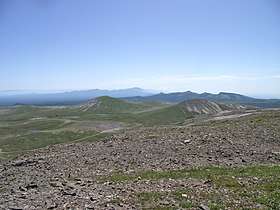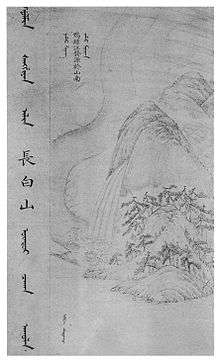Changbai Mountains
| Changbai Mountains | |
|---|---|
 View from Mount Paektu, the highest peak in the range | |
| Highest point | |
| Peak | Mount Paektu |
| Elevation | 2,744 m (9,003 ft) |
| Prominence | 2,593 m (8,507 ft) |
| Changbai Mountains | |||||||||
| Chinese name | |||||||||
|---|---|---|---|---|---|---|---|---|---|
| Simplified Chinese | 长白山脉 | ||||||||
| Traditional Chinese | 長白山脈 | ||||||||
| Literal meaning | Perpetually White Mountain-Vessel | ||||||||
| |||||||||
| Korean name | |||||||||
| Chosŏn'gŭl | 장백산맥 | ||||||||
| Hancha | 長白山脈 | ||||||||
| |||||||||
| Manchu name | |||||||||
| Manchu script | ᡤᠣᠯᠮᡳᠨ ᡧᠠᠩᡤᡳᠶᠠᠨ ᠠᠯᡳᠨ | ||||||||
| Romanization | Golmin šanggiyan alin | ||||||||
The Changbai Mountains are a major mountain range in Northeast Asia. The mountains extend from the Northeast Chinese provinces of Heilongjiang, Jilin and Liaoning, across the border between China and North Korea (41°41' to 42°51'N; 127°43' to 128°16'E), to the North Korean provinces of Ryanggang and Chagang. They are also referred to as the Šanggiyan, Jangbaek, or Ohnan mountains. Most peaks exceed 2,000 metres (6,600 feet) in height, with the highest being the Paektu Mountain.
History

The range represents the mythical birthplace of Bukūri Yongšon, ancestor of Nurgaci[1] and the Aisin Gioro imperial family, who were the founders of the Manchu state and the Qing dynasty of China. The Chinese name literally means "Perpetually-White Mountain Region".[2]
Geography and climate
The mountains are the source of the Songhua, Tumen, and Yalu Rivers.[3]
The Changbai Mountains are characterized by long and cold winters. Precipitation is low in the winter but higher in the summer and autumn with annual averages reaching as high as 1,400 millimetres (55 inches).[4]
Flora and fauna

The vegetation of the mountain slopes is divided into several different zones. At the top, above 2,000 metres, tundra predominates. From 1,700 to 2,000 metres, vegetation is dominated by mountain birch and larch. Below this zone, and down to 1,100 metres, the dominant trees are spruce, fir, and Korean pine. From 600 to 1,100 metres, the landscape is dominated by mixed forest, consisting of Amur linden, Korean pine, maple, and elm. Further down, a temperate hardwood forest is found, dominated by second-growth poplar and birch.[5]
Protected areas
Popularity
The Changbai Mountains is mentioned in the first verse of the de-facto national anthem of North Korea, Song of General Kim Il-sung. It is mentioned in the Korean name, Jangbaek.[6]
See also
References
- ↑ 愛新覺羅·瀛生《滿語口語音典》
- ↑ Crossley, Pamela Kyle (February 2000). A Translucent Mirror: History and Identity in Qing Imperial Ideology. University of California Press. p. 202. ISBN 9780520234246.
- ↑ "Changbai Mountains -- Scenic Wonderland". China.org.cn. Retrieved 12 July 2014.
- ↑ "Changbai Mountains mixed forests (PA0414)". WildWorld Ecoregion Profile, National Geographic Society. World Wildlife Fund. Archived from the original on 2010-03-08. Retrieved 9 February 2015.
- ↑ Liu, Q.J., Takamura, T., Takeuchi, N., Shao, G. (2002). Mapping of boreal vegetation of a temperate mountain in China by multitemporal LANDSAT imagery. International Journal of Remote Sensing 23(17), p. 3388
- ↑
External links
| Wikimedia Commons has media related to Changbai / Baekdu. |